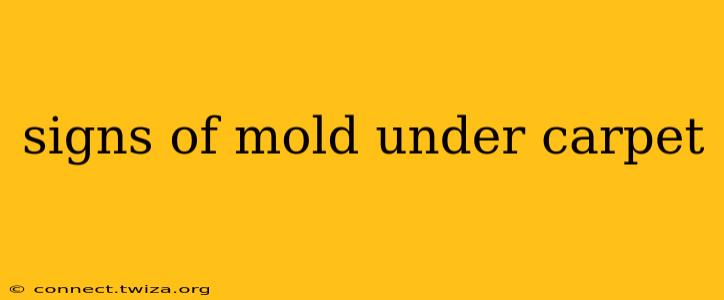Mold infestations beneath carpeting are a serious health concern, often hidden until significant damage occurs. Knowing the subtle and overt signs of mold under your carpet is crucial for preventing extensive damage and protecting your family's health. This guide will help you identify potential problems and take appropriate action.
What are the common signs of mold under a carpet?
This is a key question many homeowners ask. The unfortunate reality is that mold often hides unseen until it becomes a significant problem. However, several telltale signs can indicate a potential issue. These include:
- Musty Odor: A persistent, earthy, or musty smell emanating from your carpeted area is a major red flag. This odor is often the first sign of hidden mold growth. Even if you can't see visible mold, the smell itself should warrant investigation.
- Visible Mold: Sometimes, mold can find its way to the surface, appearing as discoloration on the carpet fibers. This discoloration can range from black, green, gray, or even white depending on the type of mold.
- Discoloration on Carpet Backing: Lifting a corner of the carpet (carefully!) can reveal discoloration or staining on the carpet padding or subfloor. Dark spots or streaks, especially if damp, are strong indicators of mold.
- Dampness or Wetness: Persistent dampness or wet areas under the carpet can promote mold growth. This can be caused by leaks, high humidity, or poor ventilation.
- Allergic Reactions or Respiratory Problems: If you or your family members experience worsening allergies, respiratory issues (coughing, sneezing, wheezing), or headaches, particularly when spending time in the carpeted area, mold could be the culprit.
How can I tell if I have mold under my carpet without removing it?
This is a tricky question, as definitively confirming mold presence usually requires inspection under the carpet. However, several non-invasive checks can help indicate a possible problem:
- Visual Inspection: Carefully examine the carpet's surface for discoloration, unusual stains, or bulging areas that might indicate moisture accumulation.
- Smell Test: Pay close attention to odors. A musty smell is a strong indicator of mold, even if you can't see it.
- Moisture Meter: A moisture meter can detect excessive moisture in the carpet and subfloor, a conducive environment for mold growth. These are readily available at most hardware stores.
What causes mold growth under carpets?
Mold thrives in damp, dark environments. Several factors can contribute to mold growth under carpets:
- Water Leaks: Leaky pipes, roof leaks, or flooding can saturate the carpet and padding, providing the perfect breeding ground for mold.
- High Humidity: Excessive humidity in the home can lead to moisture accumulation in the carpet, particularly in poorly ventilated areas.
- Poor Ventilation: Lack of proper ventilation can trap moisture, increasing the risk of mold growth.
- Spills: Untreated spills, especially if left to dry slowly, can create a moist environment ideal for mold.
What should I do if I suspect mold under my carpet?
If you suspect mold, taking immediate action is crucial:
- Identify the Source: Determine the source of the moisture or leak that may have caused the mold.
- Ventilate the Area: Improve air circulation to help dry out the affected area. Open windows and use fans if possible.
- Professional Inspection: Contact a qualified mold remediation specialist. They can properly assess the extent of the mold infestation and recommend appropriate remediation. Do not attempt to remove extensive mold yourself without proper training and equipment. This can spread spores and worsen the problem.
Can I remove mold under my carpet myself?
While you might be tempted to tackle this yourself, attempting extensive mold removal without professional training and safety equipment is strongly discouraged. Mold spores can be harmful if inhaled, and improper removal can lead to a more widespread problem. Professional remediation ensures safe and effective removal.
Remember, prevention is key. Regularly inspect your carpets for signs of dampness or discoloration. Ensure your home has adequate ventilation and address any water leaks promptly. By being proactive, you can minimize the risk of costly and health-threatening mold infestations.
